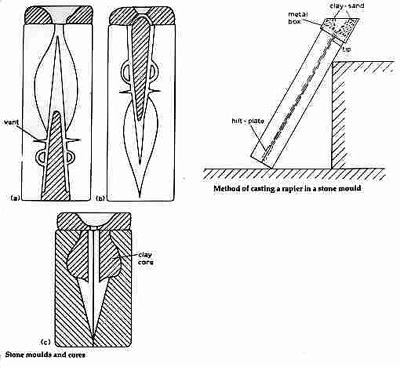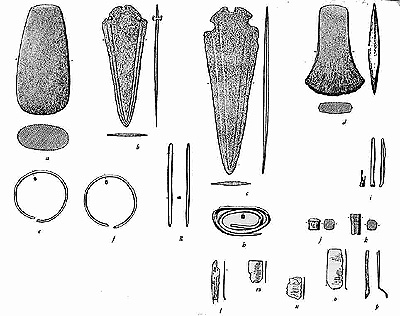There are more images about the Late Bronze Age on the next site
There are more images about the Iron Age on the next site (#1)
There are more images about the Iron Age on the next site (#2)
There are more images about bronze casting techniques on the next site
Index Dutch Bronze Age
Index first farmers in the Netherlands
Drawings and images about findings from the
Early and Middle Dutch Bronze Age
(2000 B.C.E. - 1100 B.C.E.)
I hereby wish to thank Mr. Sander van Houthum for his help in making this page possible.
All findings come from the Netherlands, unless otherwise specified.
Hair-nets; the right one is made from hairs of a horse-tail, with the "sprang- technique". It was held on its place by a 5m long, woolen "net-lace". Dk, Late Bronze Age.

Artist's impression of a Bronze Age bronze caster.

A pair of bracelets, Middle Bronze Age, Elp culture, Ballooėrveld.

Bronze-casting with foot-bellows: open hearth, bellowing and casting of bars. Thebe, Egypt, ± 1450 B.C.E. (during Thutmosis III) An inscription in the same barrow depicted: "They bring Asian copper (=tin-bronze from Byblos, after about 2500 B.C.E...), which was brought by His Majesty, victorious, from the hills of Syria to cast the doors of the barrow of Amon in Karnak ..."

Bronze-casting with foot-bellows: above the furnace one can clearly identify the so-called "ox-skin bars" (in real painted red). These were copper bars that were shaped like ox-skins and weighted about 65 kg so they could be transported by one person. Below the ox-skin there's a blue-grey bar which probably points to tin.
Thebe, Egypt, ± 1380 B.C.E. (during Amenhoteps III)

Bronze smelting with reconstructed "foot bellows"

Bronze spearhead with small "ears", made in the U.K., but found in Bodegraven. Middle Bronze Age.

Leende, Early Bronze Age, bronze dagger with two rivets
Hoogeloon, 16th century B.C.E., chisel

Overloon, 1500 - 1350 B.C.E. bronzes:
a) decorated spearhead
b) spearhead
c) axe
d) toggle pin
e) f)swords
g) reconstructed positions
Veenendaal, decorated bronze pins

Weerdinge, Early to Middle Bronze Age, bronze pin with a piece of wool

Voorhout, 1400 - 1350 B.C. various types of British type axes, a total of 18 ... and a chisel with knobs.

Jutphaas, Middle Bronze Age, sacred sword. Another one has been found near Ommerschans and near Utrecht (see Rijksmuseum voor de Oudheid in Leiden)

Epe, 1200 - 1100 B.C. 2 palstaves (axes), a sickle

Early and Middle British Bronze Age stone mould for a sword and Late Bronze Age clay moulds for spears.
The hilt plate is the bottom part of the stone sword mould.
A metal box supports the clay - sand mixture on the top.
The stone mould must stay open about 0,65 mm to let the gases escape.
The "vents" in the clay spear moulds prevent gas bubbles in the bronze results.
The stone moulds were commonly used in the (British) Early and Middle Bronze Age,
clay moulds were mostly in use during the Late Bronze Age. No prehistoric stone moulds have been found in the Netherlands for so far.

One of the first real Dutch Bronze Age graves, Wageningen, about 1700 B.C.E.
a)stone axe
b)c)"halberds"
d)flat axe
e)f)bracelets
g)h)i)ingots
j)k)not yet finished rivets
l)m)n)o)flat pieces of bronze
p)unidentified bronze object

Information about the author / editor
April, 6th 1998